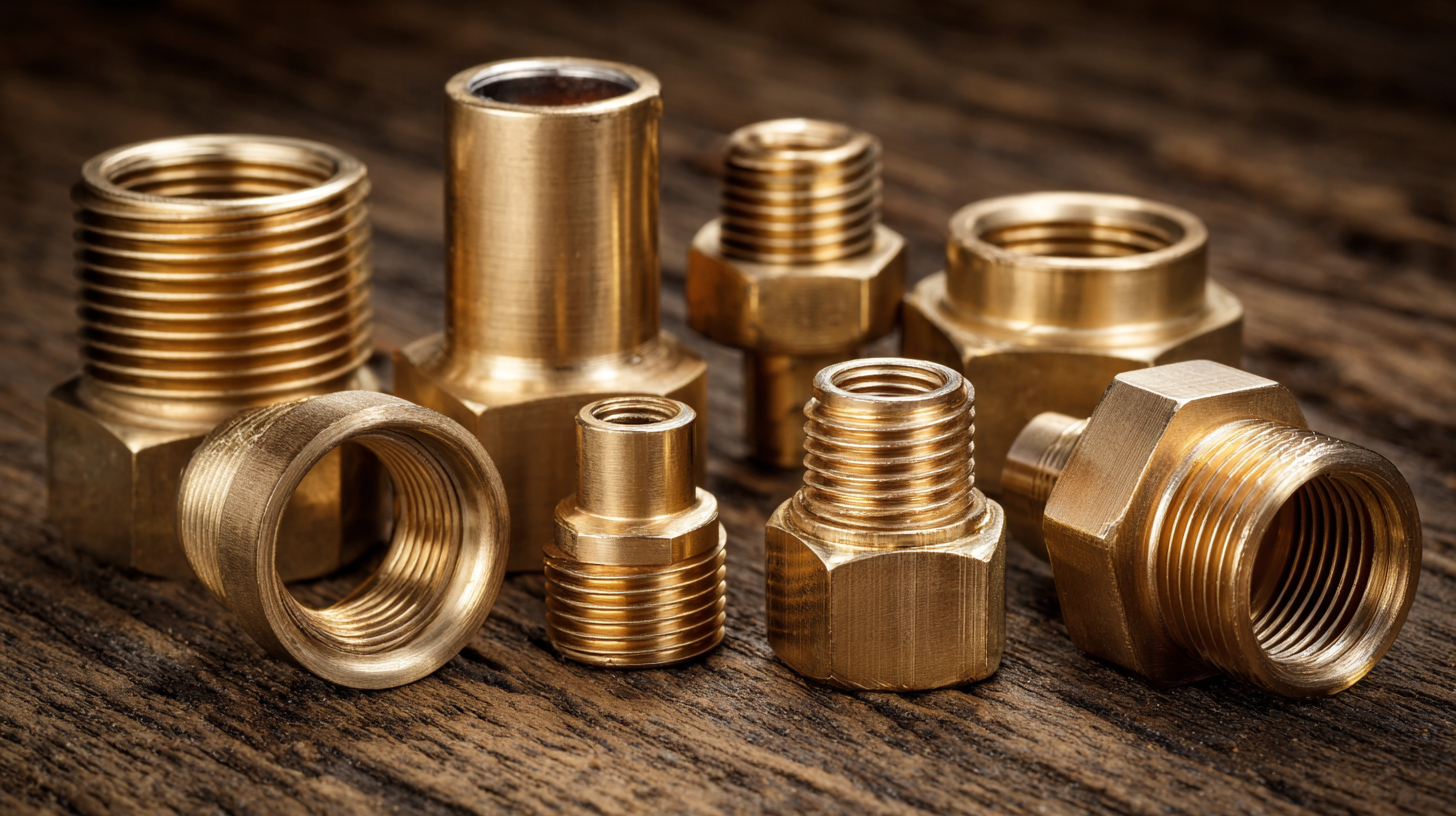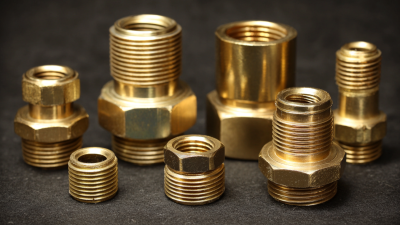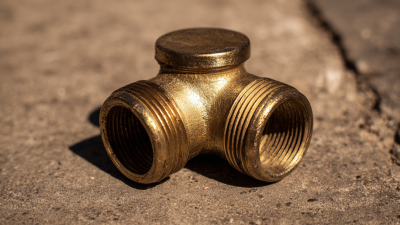The Ultimate Guide to Choosing the Right Brass Fittings for Your Plumbing Needs
When it comes to plumbing applications, selecting the appropriate brass fittings is crucial for ensuring system reliability and longevity. Brass fittings, known for their durability and corrosion resistance, play a vital role in facilitating effective water flow and maintaining system pressure. According to a report by the Plumbing Manufacturers International (PMI), brass fittings account for approximately 30% of the total fittings market used in residential plumbing, underscoring their widespread adoption due to their excellent thermal and mechanical properties. Additionally, the global brass fittings market is projected to grow at a CAGR of 4.5% from 2021 to 2026, highlighting the increasing demand for high-quality plumbing solutions. In this guide, we will delve into the various types of brass fittings available, the essential factors to consider when selecting them, and how to ensure they meet your specific plumbing needs.

Understanding the Different Types of Brass Fittings for Plumbing Applications
When selecting the appropriate brass fittings for plumbing applications, it is essential to understand the different types available on the market. Brass fittings come in various forms, including elbows, tees, unions, and adaptors, each designed for specific functions in plumbing systems. These components facilitate connections between pipes, allowing for smooth transitions in both residential and commercial plumbing. The versatility of brass fittings, combined with their resistance to corrosion, makes them a reliable choice for installers.
Recent advancements have also improved how fittings are made, especially with the advent of lead-free brass options, which align with health and safety standards. Understanding how these materials are processed is crucial; for instance, saws and blades have been optimized to cut lead-free brass efficiently, ensuring high-quality fittings. Additionally, innovations like metal push-fit systems have made installations easier, providing a seamless experience for plumbers by reducing the time and effort required to achieve secure connections. As familiarity with these types grows, installers can better meet their plumbing needs, ensuring durability and safety in their projects.

Key Factors to Consider When Selecting Brass Fittings for Your Project
When selecting brass fittings for your plumbing project, several key factors must be considered to ensure optimal performance and longevity. First and foremost is the fitting's compatibility with various pipe materials. According to a 2022 report by the Plumbing Manufacturers International (PMI), nearly 30% of plumbing failures are attributable to the use of mismatched materials, leading to leaks and reduced system efficiency. Therefore, choosing brass fittings that seamlessly integrate with your pipes—be it PVC, PEX, or copper—is vital for reducing maintenance costs in the long run.
Another critical factor is the fitting's corrosion resistance. A 2021 study by the National Association of Plumbing Contractors found that fittings with a superior resistance to corrosion exhibited a lifespan 20-30% longer than standard brass options, particularly in areas with hard water. It's important to assess whether the fittings meet ASTM standards, which ensure quality and durability in various environmental conditions. In addition, you'll want to evaluate the fitting's pressure rating to ensure it can handle the demands of your plumbing system, with most residential applications requiring fittings rated for at least 150 PSI. By considering these factors, you can make informed choices that will enhance your plumbing system's overall reliability and effectiveness.
The Ultimate Guide to Choosing the Right Brass Fittings for Your Plumbing Needs
| Fitting Type | Size | Thread Type | Max Pressure (psi) | Temperature Range (°F) | Applications |
|---|---|---|---|---|---|
| Elbow | 1/2" | NPT | 200 | -25 to 200 | Plumbing, HVAC |
| Tee | 3/4" | NPT | 150 | -40 to 120 | Water Supply, Gas |
| Coupling | 1" | NPT | 300 | -40 to 180 | General Purpose, Fuel |
| Union | 1/4" | NPT | 250 | -20 to 150 | Connecting Pipes, Repair |
| Cap | 1/2" | NPT | 150 | -50 to 100 | End of Pipes, Capping |
Top 5 Benefits of Using Brass Fittings in Plumbing Systems
When it comes to plumbing systems, selecting the right materials is crucial for ensuring longevity and reliability. Brass fittings are an excellent choice due to their numerous benefits. Firstly, they are highly resistant to corrosion, which makes them ideal for use in various plumbing applications, especially those involving water. The durability of brass fittings contributes to reducing the need for frequent replacements, ultimately saving time and money for homeowners and professionals alike.
Another significant advantage of using brass fittings is their excellent mechanical strength. This characteristic enables them to withstand high pressures without the risk of leaks, making them suitable for both residential and commercial plumbing systems. Moreover, advancements in technology have led to the development of lead-free brass alloys, addressing health concerns related to lead leaching. With features like these, brass fittings play an essential role in sustainable plumbing solutions, ensuring safe and efficient water delivery while adhering to modern safety standards.
The Ultimate Guide to Choosing the Right Brass Fittings for Your Plumbing Needs
This chart illustrates the top five benefits of using brass fittings in plumbing systems. Each benefit is rated on a scale of 0 to 100, demonstrating the advantages of choosing brass for durability, corrosion resistance, cost-effectiveness, thermal conductivity, and ease of installation.
Common Mistakes to Avoid When Choosing Brass Fittings for Plumbing
When choosing brass fittings for your plumbing needs, avoiding common mistakes can significantly enhance your project’s outcome. Many people overlook the importance of compatibility. It’s crucial to ensure that the fittings you choose match the existing pipes in terms of size and threading. Mismatched fittings can lead to leaks and costly repairs. Additionally, selecting fittings made from low-quality brass can reduce durability, leading to failures over time.
Another common pitfall is negating the long-term implications of water pressure and flow rate. Many homeowners often focus solely on the aesthetics or initial cost, but it’s vital to consider how the fittings will perform under daily use. Proper research on the specifications of the fittings can prevent issues down the line.
Lastly, seeking professional advice can help avoid the pitfalls of DIY errors; consulting with experts ensures that you make informed decisions tailored to your plumbing system's specific requirements.
How to Maintain and Care for Brass Fittings to Ensure Longevity
When it comes to maintaining brass fittings, regular care is essential to ensure their longevity and performance in your plumbing system. One of the key steps is to keep the fittings clean and free of corrosion. Regularly wipe them down with a soft cloth dampened with soapy water, followed by a rinse with clean water. This simple practice helps prevent the buildup of debris and grime that can lead to corrosion over time.

Tips: Use a mixture of vinegar and baking soda for stubborn stains or tarnish on your brass fittings. Apply the paste and let it sit for a few minutes before scrubbing gently with a soft brush. Rinse thoroughly and dry to restore the fittings’ shine.
Additionally, it’s crucial to inspect your brass fittings regularly for any signs of wear or leaks. Check for any discoloration, which might indicate corrosion, or pinholes that could lead to leaks. Early detection of these issues can save you from costly repairs and ensure that your plumbing system remains efficient.
Tips: Consider using a sealant specifically designed for brass fittings to provide an extra layer of protection against moisture and corrosion. This can significantly extend the life of your fittings and enhance their overall durability.
Related Posts
-

How to Choose the Right Brass Fittings for Optimal Plumbing Efficiency
-

Essential Checklist for Choosing the Right Brass Elbow for Your Project
-

The Ultimate Guide to Sourcing High-Quality Brass Fittings for Your Business Needs
-

How to Choose the Best Brass Elbow for Your Plumbing Needs
-

Understanding the Benefits of Using Brass Elbow Fittings in Plumbing Systems
-

Discover Innovative Examples of Quick And Easy Fittings Solutions
